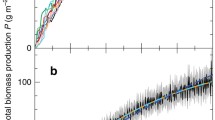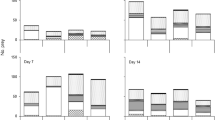Summary
It is well known that the stock abundance of a pelagic fish usually fluctuates and a species of pelagic fish which was dominant in abundance is often taken over by another species. Several alternative models for species replacement among pelagic fishes are presented and analyzed: (A) environmental fluctuation, (B) strong density-dependent reproduction rate, (C) a two-species system with phase variation (density-dependent change of life history traits), (D) a two-species competition system with environmental fluctuation, (E) cyclic advantage relationship among three competitive species, and (F) a two-prey, one-predator system. Different model requires different number of species for the occurrence of species replacement. Three criteria to test each hypothesis from qualitative properties of species replacement are proposed. Possible management policies to decrease the amplitude of stock fluctuations are discussed. As a result, if the catching effort to mackerels which is rare now is large, or if the catching effort to the sardine is still large when it begins to decline in stock abundance, fisheries may be strong destabilizing effect on the stock abundance.
Similar content being viewed by others
References
Chitty, D. (1960) Population processes in the vole and their relevance to general theory.Can. J. Zool. 38: 99–113.
Connor, E. F. and D. S. Simberloff (1979) The assembly of species communities: chance or competition?Ecology 60: 1132–40.
Fujii, K. (1977) Complexity-stability relationship of two-prey-one-predator species system model: Local and global stability.J. theor. Biol. 69: 613–623.
Gilpin, M. E. (1975) Limit cycles in competition communities.Am. Nat. 109: 51–60.
Hofbauer, J. and K. Sigmund (1988)The Theory of Evolution and Dynamical Systems. Cambridge Univ. Press, Cambridge.
Kawai, T. (1987) A study on variability of marine teleost resources from a viewpoint of comparative ecology.Bull. Tokai Reg. Fish. Res. Lab. 122: 49–127 (in Japanese with English abstract)
Kawai, T. and T. Takahashi (1983) Changes of species composition and diversity of Japanese fishes in the 20th century by each region and living layer.Datum Collect. Tokai. Reg. Fish. Res. Lab. Tokyo, No. 11: 1–128.
Kawasaki, T. (1983) Why do some pelagic fishes have wide fluctuations in their numbers?—Biological basis of fluctuation from the viewpoint of evolutionary ecology. 1065–80. In G. D. Sharp and J. Csirke (eds)Proceedings of the Expert Consultation to Examine Changes in Abundance and Species Composition of Neritic Fish Resources, FAO Fish. Rep. 291(3).
Lande, R. (1979) Quantitative genetic analysis of multivariate evolution, applied to brain-body size allometry.Evolution 33: 402–416.
Lewontin, R. C. (1968) Evolution of complex genetic systems. In M. Gerstenhaber (ed)Some Mathematical Questions in Biology. Amer. Math. Soc., Providence, R. I.
Macfadyen, A. (1963)Animal Ecology. Pitman, London.
Matsuda, H. (1985) Evolutionarily stable strategies for predator switching.J. theor. Biol. 115: 351–366.
Matsuda, H., K. Kawasaki, N. Shigesada, E. Teramoto and L. M. Ricciardi (1986) Switching effect on the stability of the prey predator system with three trophic levels.J. theor. Biol. 122: 251–262.
Matsuda, H., K. Kawasaki, N. Shigesada, E. Teramoto and L. M. Ricciardi (1987) Evolutionary and ecological stability of prey-predator systems with predatory switching. 172–181. In E. Teramoto and M. Yamaguti (eds)Mathematical Topics in Population Biology, Morphogenesis and Neurosciences, Lecture Notes in Biomathematics 71, Springer-Verlag. Berlin.
May, R. M. (1975) Biological populations obeying difference equations: Stable points, stable cycles, and chaos.J. theor. Biol. 51: 511–524.
May, R. M. and R. M. Anderson (1983) Epidemiology and genetics in the coevolution of parasites and hosts.Proc. Roy. Soc. Lond. B. 219: 281–313.
May, R. M. and W. J. Leonard (1975) Nonlinear aspects of competition between species.SIAM J. Appl. Math. 29: 243–253.
Nakai, Z. (1962) Studies relevant to mechanisms underlying the fluctuation in the catch of the Japanese sardine,Sardinops melanosticta (Temminck et Schlegel).Japan. J. Ichthy. 9: 1–115. (in Japanese)
Parker, G. A. (1985) Population consequences of evolutionarily stable strategy. In R. M. Sibly and R. H. Smith (eds)Behavioral Ecology: Ecological Consequences of Adaptive Behaviour. Symposia of the British Ecological Society,25: 33–58, Blackwell, Oxford.
Ricker, W. E. (1954) Stock and recruitment.J. Fish. Res. Boadd Canada 11: 559–623.
Roff, D. A. (1986) The evolution of wing dimorphism in insects,Evolution 40: 1009–1020.
Roughgarden, J., (1983a) Competition and theory in community ecology.Am. Nat. 122: 583–601.
Roughgarden, J. (1983b) The theory of coevolution. 33–64. In D. J. Futuyma and M. Slatkin (eds)Coevolution, Sinauer, Sunderland, MA.
Rummel, J. and J. Roughgarden (1985) A theory of faunal buildup for competition communities.Evolution 39: 1009–1033.
Shirakihara, K. and S. Tanaka (1981) A predator-prey model for two-species populations with nonlinear interactions and implications for fisheries management.Bull. Jpn. Soc. Sci. Fish. 47: 487–493.
Taka, S., M. Kitakata and T. Wada (1982)Bull. Hokkaido Reg. Fish. Res. Lab. 47: 41–55 (in Japanese with English abstract)
Takeuchi, Y. (1989) Diffusion-mediated persistence in two-species competition Lotka-Volterra model,Math. Biosci. 95: 65–83.
Wada, T. (1988) Population dynamics on Japanese sardine,Sardinops melanostictus, caught by the domestic purse seine fishery in the waters off the coast of southeastern Hokkaido.Bull. Hokkaido Reg. Fish. Res. Lab. 52: 1–138. (in Japanese with English Abstract).
Author information
Authors and Affiliations
Rights and permissions
About this article
Cite this article
Matsuda, H., Wada, T., Takeuchi, Y. et al. Alternative models for species replacement of pelagic fishes. Res Popul Ecol 33, 41–56 (1991). https://doi.org/10.1007/BF02514573
Issue Date:
DOI: https://doi.org/10.1007/BF02514573




